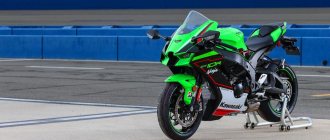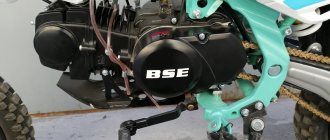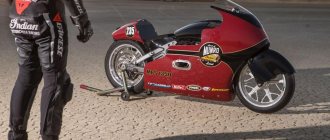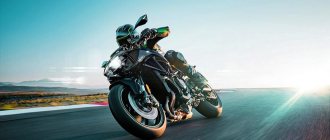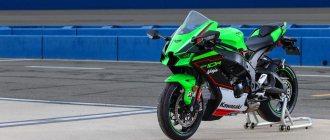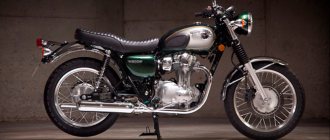KX 250 F
- Kawasaki motorcycle model
The Kawasaki KX250F motocross motorcycle model appeared in 2004 as a replacement for the 2-stroke motocross versions of the Kawasaki KX250 and Kawasaki KX125. The first versions of the motorcycle were developed jointly with Suzuki - in the first years of production, there were two absolutely identical models on the market, Kawasaki KX250F and Suzuki RM-Z250.
In 2006, the KX250F was restyled and moved away from the concept common to the RMZ250, becoming an independent model. The updated version received a new generation of frame, redesigned engine, suspension and Renthal steering wheel.
The model is redesigned again for 2009, receiving updated exterior styling as well as redesigned engine, suspension and chassis components (to reduce weight and improve handling).
In 2010, Kawasaki released a new generation of the KX250F, although visually the model was very similar to the previous generation.
2011 was marked by another restyling of the Kawasaki KX250F, which received electronic fuel injection and a new Showa Separate Function front Fork (SFF). In 2012, a second injector was added to the fuel injection system, which slightly increased maximum power.
In 2013, the model undergoes changes again, receiving a new appearance, new settings for the injection system, engine and suspension.
For 2021, Kawasaki has introduced a new generation of the KX250F. The engine and suspension settings were changed again, the size of the front brake disc increased, and the curb weight decreased by almost 2 kg. Additional electronic accessories are also offered:
KX FI Calibration Kit
DFI Couplers
Launch Control Mode
For 2021, the model is undergoing changes again, receiving a new engine, increased brake disc sizes (270 and 250 mm) and other small differences. The model also changes its name, removing the letter F - Kawasaki KX250.
For 2021, Kawasaki introduced the new generation KX250. The updated version received a new frame, a new engine, a new electric starter system and a hydraulic clutch drive.
Brief history of the model
2004 - start of production and sales. First generation. Model: Kawasaki KX250F (North America, Europe, Australia, Japan). Factory designation: KX250-N1.
2005 - no significant changes. Model: Kawasaki KX250F (North America, Europe, Australia, Japan). Factory designation: KX250-N2.
2006 - restyling of the model. Second generation. Model: Kawasaki KX250F (North America, Europe, Australia, Japan). Factory designation: KX250T6F.
2007 - no significant changes. Model: Kawasaki KX250F (North America, Europe, Australia, Japan). Factory designation: KX250T7F.
2008 - no significant changes. Model: Kawasaki KX250F (North America, Europe, Australia, Japan). Factory designation: KX250T8F.
2009 - restyling of the model. Third generation. Model: Kawasaki KX250F (North America, Europe, Australia, Japan). Factory designation: KX250W9F.
2010 - restyling of the model. Fourth generation. Model: Kawasaki KX250F (North America, Europe, Australia, Japan). Factory designation: KX250XAFA, KX250XAFB.
2011 - restyling of the model. Fifth generation. Model: Kawasaki KX250F (North America, Europe, Australia, Japan). Factory designation: KX250YBF.
2012 - the model receives a dual fuel injection system, which includes a lower and upper injector. The lower injector is responsible for a constant, uniform response from the throttle, and the upper injector is responsible for increasing power. As the speed increases, the computer unit switches from the lower to the upper injector. Model: Kawasaki KX250F (North America, Europe, Australia, Japan). Factory designation: KX250YCF.
2013 - restyling of the model. Sixth generation. Model: Kawasaki KX250F (North America, Europe, Australia, Japan). Factory designation: KX250ZDF.
2014 - no significant changes. Model: Kawasaki KX250F (North America, Europe, Australia, Japan). Factory designation: KX250ZEF.
2015 - no significant changes. Model: Kawasaki KX250F (North America, Europe, Australia, Japan). Factory designation: KX250ZFF.
2016 - no significant changes. Model: Kawasaki KX250F (North America, Europe, Australia, Japan). Factory designation: KX250ZGF.
2017 - restyling of the model. Seventh generation. Model: Kawasaki KX250F (North America, Europe, Australia, Japan). Factory designation: KX252AHF.
2018 - no significant changes. Model: Kawasaki KX250F (North America, Europe, Australia, Japan). Factory designation: KX252AJF.
2019 - no significant changes. Model: Kawasaki KX250F (North America, Europe, Australia, Japan). Factory designation: KX252AKF.
2020 - restyling of the model. Eighth generation. Model: Kawasaki KX250 (North America, Europe, Australia, Japan). Factory designation: KX252BLF.
2021 - restyling of the model. Ninth generation. Model: Kawasaki KX250 (North America, Europe, Australia, Japan). Factory designation: KX252CMFNN.
REVIEW – 2021 KAWASAKI KX250 – Fastest 4-Stroke in the Class
The Japanese philosophy in creating the KX crossenduro series is to provide professional athletes with the best machine for conquering podiums. For more than 40 years, the manufacturer has managed to maintain its brand in the 250 cc enduro class, despite fierce competition. And the new mid-volume KAWASAKI KX250 will come into 2021 with a strong claim to the title of the fastest crossbike of the season.
An engine pumped to the limit, an even more balanced chassis with a new fork, powerful brakes - these are the main advantages of a qualitatively new mid-volume bike, which will certainly help the rider to cover the track faster, leaving far behind competitors on motorcycles of other famous brands.
Taking an impartial look at the bike, you might think that it is still the same high-quality 250 cc bike, pleasing with high-quality performance, but lacking stars from the sky. It's worth reading the technical information about the new KAWASAKI KX250 to understand how wrong this is!
2021 KAWASAKI KX250 - it's never been like this before!
2021 KAWASAKI KX250 Engine
While tweaking the parameters of the 249 cc engine of the new motocross star, KAWASAKI engineers focused on the high rev range. It was possible to significantly increase the peak power through the use of a new head and restructuring of the intake and exhaust.
The 2021 KAWASAKI KX250 cylinder head uses rockers to drive the valves, similar to the super-performance engine of the legendary sports car KAWASAKI Ninja ZX-10RR. The solution made it possible to painlessly raise the bar for maximum speed and apply a more aggressive camshaft cam profile.
Pumped up 2021 KAWASAKI KX250 engine
This is not the end of the list of modifications to the 249 cc heart, but just the beginning. The full list of changes looks like this:
Piston diameter increased from 77.0 mm to 78.0 mm.
Reduced piston stroke from 53.6 mm to 52.2 mm.
Intake valves are lighter by 3.5%, exhaust valves by 4.3%, taking into account the increased valve diameter.
Intake diameter expanded by 1 mm and exhaust by 1.5 mm.
Moves the cylinder 3mm forward to improve performance and improve engine balance.
Changed cylinder honing technology, reducing friction while maintaining the ability to retain oil on the walls.
The piston has been changed - with an increase in diameter, the skirt has been shortened and the walls have been strengthened.
Increased compression ratio - from 13.4:1 to 14.2:1
Reduced air filter box with an intake tract shortened by 50 mm and an intake funnel with reduced aerodynamic drag.
Increasing the throttle valve diameter by 1 mm.
Reduced outlet length by 30 mm, connecting pipe with reverse taper.
New 2021 KAWASAKI KX250 Engine Piston
Such a wide range of effective engine refinements entailed increased consumption of the air-fuel mixture, so in the 2021 KAWASAKI KX250, improvements were also made to the injection system. Gasoline enters the cylinder through a dual injector system tuned for increased appetite.
The rebuilt engine is capable of producing 3.3 hp. (2.4 kW) more power, which is clearly felt when spinning the single-cylinder monster above 10,000 rpm. Riders who are lucky enough to ride the new KX250 for the 2021 season will enjoy an undeniable advantage both on long straights and when cornering thanks to the improved elasticity of the engine.
Chassis of the new KAWASAKI KX250 2021
In the world of high power, no serious engine upgrade is complete without rebuilding the chassis. The KAWASAKI KX250 cross bike was no exception, for which the combination of the necessary strength and flexibility of the power frame is especially important.
The lightweight aluminum frame is a precisely calculated structure consisting of elements of different sections and manufacturing principles - cast, extruded and forged parts are used in the frame. The complex manufacturing scheme affects the final price of the KAWASAKI KX250, but provides the athlete with a sense of perfect balance and confidence when passing the most difficult sections of the treacherous off-road track.
KAWASAKI engineers chose the center of gravity of the machine, the mounting axis of the rear pendulum and the location of the sprockets so that the powerful motorcycle maintains rapid acceleration for as long as possible instead of spectacular, but ineffective slipping and jumping into the “candle”.
The power structure of the KAWASAKI KX250 has undergone a number of changes for the 2020 version. The modified motor mounting system with the transition from through bolts to studs made it possible to obtain greater structural rigidity while maintaining the necessary margin for bending and torsion.
The new 48mm front fork with larger tubes and damping pistons provides improved shock absorption early in the stroke and optimal energy capacity throughout the entire range.
Updated fork and rear monoshock for 2020 KAWASAKI KX250
New springs increase stiffness in the front fork from 9.4 N/mm to 10.0 N/mm and in the rear shock absorber from 52 N/mm to 54 N/mm to help the suspension cope with the increased load due to the increased power of the 249 cc engine .
The KAWASAKI KX250's petal brakes also get an upgrade for the 2021 version. Updates to this system include updated front caliper pads made from material borrowed from the older KAWASAKI KX450 enduro bike, an increased rear disc diameter from 240 mm to 250 mm, and a lightweight master cylinder from the KX450.
KAWASAKI KX250 rear brake disc increased by 10 mm
The list of updates for the 2021 KX250 model range looks more than impressive, but the bike has retained many important features from previous versions.
First of all, this is high-quality sports ergonomics, allowing the rider to quickly take the most advantageous positions for the fastest possible passage of the route with dynamically changing traffic conditions. The KAWASAKI KX250 is equipped with the proprietary ERGO-FIT system, which allows you to precisely adjust the controls to the rider's parameters.
The new bike remains faithful to the legendary bow of KAWASAKI enduro models. Bold, sharp and fast, he will proudly wear the juicy branded “lime green” color in 2020, not allowing either spectators or judges of off-road races to doubt who is in charge on the track!
2021 KAWASAKI KX250 Official Video
2021 KAWASAKI KX250
2021 Kawasaki KX™ 250
Motorcycle The Kawasaki KX™ 250 motorcycle has more AMA motocross and supercross championships than any other manufacturer in its class, and returns for 2021 with a list of improvements that are designed to continue its winning history while keeping it the best motorcycle on the track. The 2021 model builds on engine changes from the previous year to deliver even more power and make it the most powerful KX250 to date. In addition to the high-revving engine, it now features a new electric start, a new tapered disc spring hydraulic clutch and a new thin aluminum perimeter frame that improves handling and faster lap times, making the KX250 even more powerful on the racetrack. With a championship heritage that boasts 18 AMA Pro titles and 189 race victories since 2004, the KX250 is the ideal mid-level platform for experienced riders looking to climb to the top of the podium.
The KX250 motorcycle is infused with a high level of technology and KX™ DNA, so you can become the next prodigy. Its power, handling and tunability personalize the bike's feel and provide greater confidence for motocross riding at all levels. The powerful KX250 engine features upgraded top and bottom ends for increased power, upgraded brakes provide greater control while harnessing the power of a more powerful engine, as well as an updated KX™ 450-style frame and fine-tuned suspension to create the ultimate performance package.
2021 KX250 Highlights
- NEW More powerful engine
- NEW Electric start
- NEW Conical disc spring hydraulic clutch
- NEW Lightweight aluminum all-round frame
- NEW Precisely tuned race-ready suspension and brake components
- NEW Slim, ergonomic body
ENGINE
- NEW Engine with increased peak power
- NEW Treatments for inlet and outlet ports
- NEW Timing exhaust gases
- NEW Stiffer valve springs
- NEW Combustion chamber design and flat piston head
- NEW Longer connecting rod
- NEW Lightweight crankshaft design
- NEW Revised crankcase pressure balance
- NEW Conical disc spring hydraulic clutch
- NEW Electric start at the touch of a button
- NEW Lightweight, compact lithium-ion battery
While the 2020 KX250 has already benefited from a significant increase in power thanks to the use of a finger-tappet valve actuator, the 2021 KX250 engine has undergone additional changes to further increase peak power and provide an even higher rev limit, while significantly increasing low end rotation speed. average performance
This four-stroke liquid-cooled engine has a displacement of 249 cc. Designed for best racing performance, the CM is geared towards higher RPMs thanks to improvements gained from Kawasaki factory racing.
The 2021 KX250 becomes Kawasaki's first motocross motorcycle to feature an electric start 250, which is activated by pressing a button located on the handlebar near the right hand grip, making starting easy and convenient. The ability to quickly restart the engine can mean the difference between maintaining your lead or having to fight your way through the pack in intense racing situations. A lightweight, compact lithium-ion battery helps keep weight down, as does the exhaust cam-mounted automatic centrifugal decompression system, which lifts one exhaust valve for easier starting.
In addition to electric start, the 2021 KX250 also becomes Kawasaki's first 250 motocross bike to feature a conical disc spring hydraulic clutch. The new high-capacity conical disc spring clutch provides a straighter feel and lighter pull for easier lever action, reducing fatigue on the racetrack. The use of a tapered disc spring results in easier clutch actuation when the lever is retracted and a wider range of engagement for easier control. To provide clean separation and reduce drag when the clutch retracts, the friction plates have been designed with offset segments. The fluid clutch is designed to provide a more consistent feel with minimal change in clutch clearance as the clutch heats up during heavy use.
The use of finger-follower valve actuation, a valve train developed by Kawasaki World Superbike engineers, allows for a high rev limit and allows for more aggressive cam profiles for higher rev performance. Diamond-like carbon coating on the finger helps protect against wear. The aggressive cams are complemented by large-bore, high-lift intake and exhaust valves that move more air and contribute to strong power. The machining for the intake and exhaust ports has been revised with a new larger diameter angle that helps improve performance. The cams use a thin and highly durable soft nitride gas treatment to reduce wear and improve reliability at high rpm, and the exhaust cam speed has been reduced by 3º to improve engine performance. Lightweight titanium valves reduce reciprocating weight and provide high rotational reliability, and valve springs now have a higher spring rate to match the higher rev limit. The addition of a 3mm extension rod reduces the lateral force on the cylinder walls as the piston moves up and down, helping to reduce mechanical losses and improve reliability. The cylinder is shifted 3 mm forward, which reduces mechanical losses and improves engine performance. A cylinder head-mounted cam chain tensioner improves the KX250's reliability by compensating for increased stress from the aggressive camshaft and high-rpm engine.
The plateau honing process with the cylinder bore results in a smooth surface with good oil retention. The smooth surface also helps reduce mechanical losses and improve power. A revised combustion chamber design and flatter piston head contribute to improved performance. The high performance piston is the same design used by Kawasaki factory racers and delivers high performance at all rpms. The short skirt, reinforced external ribs and the use of an internally mounted bridge box piston provide a lightweight and durable piston design. A dry film lubricant coating on the piston skirts reduces friction at low rpm and aids in the piston lapping process.
To reduce weight, an update was made to the crankshaft web design and the pressure balance within the crankcase was revised, increasing engine performance. Low friction journal bearings on the crankshaft pin help reduce mechanical losses and improve overall performance. To strengthen the drivetrain, the center distance has been revised to match the increased engine power. In addition to changing the center distance, the shape-optimized gears contribute to weight reduction.
The airbox design features a shorter, tapered intake runner for improved high-rpm performance. The KX250 was the first production motocross motorcycle to feature dual injectors, an injector downstream of the throttle designed to provide smooth, immediate response, and a second, upstream injector located adjacent to the airbox for a significant contribution to engine power at high speeds. The exhaust system's length helps improve high-rpm performance, and the hydroformed pipe features a reverse-taper design. The large throttle body allows a large volume of air to flow and provides increased performance at high rpm. In addition to Kawasaki's engineering efforts to optimize airflow, the intake duct placement allows direct access to intake air. The downdraft style intake system increases the angle at which intake air enters the cylinder, improving cylinder filling efficiency and increasing engine power.
DFI® COUPLINGS
With superior engine performance, the KX250's digital fuel injection system features an industry-standard hitch package. Every KX250 motorcycle comes standard with three different clutches, allowing riders to easily select pre-programmed fuel injection and ignition mapping to suit their riding style or track conditions. DFI® four-pin zip ties select cards that are designed for standard, hard or soft terrain conditions. Changing the engine map is as simple as connecting the cap of choice. For riders who want to fine-tune their ECU settings, the KX™ FI Calibration Kit (Manual) is offered as a genuine Kawasaki accessory and provides access to a fully programmable ECU. Used by factory racing teams, the portable device eliminates the need for a portable laptop and gives racers the ability to create their own maps to fine-tune fuel and ignition parameters. The handy device can store up to seven pre-installed cards and is PC compatible.
LAUNCH CONTROL
The KX250's launch control system is a major benefit and a favorite for riders who are focused on reaching the first turn ahead of their competitors. Push-button activation retards ignition timing in first and second gear, helping to maximize traction on slippery surfaces like concrete launch pads and put the bike's powerful power to the ground. As soon as the driver shifts into third gear, normal ignition mapping is immediately resumed and full power is restored.
CHASSIS
- NEW Thin aluminum perimeter frame based on KX™ 450
- NEW The engine is used as a hard penis
- NEW Steering head area with optimized rigidity
- NEW KX450 swingarm for increased rear traction
The KX250's new slim all-round aluminum frame is based on that of the KX450 and features lightweight, flexible handling and slim ergonomics. Its design is a lightweight construction consisting of forged, extruded and cast parts. The new frame provides a better overall stiffness balance, and while many parts are shared with the KX450 frame, castings such as the shock and engine mounts were designed specifically for the KX250's needs. Adding balance to frame stiffness is using the engine as a stress member. The steering head area, main frame rails with updated cross sections, line for the swing arms and wider lower frame rails have been revised and contribute to the overall stiffness balance.
The addition of the KX450's swingarm provides the stiffness needed to match the frame and helps increase rear wheel traction. The center of gravity and key dimensions such as the swing arm pivot, output sprocket and rear axle placement were carefully chosen to ensure the rear wheel propels the bike.
SUSPENSION AND BRAKES
- NEW Lower triple clamp
- NEW Revised coupling coefficients
- NEW Finely tuned front and rear suspension parameters
- NEW Smaller diameter rear disc 240 mm
- NEW KX450 Front Master Cylinder
The KX250 features 48mm KYB inverted coil spring front forks that provide optimal action early in the fork's stroke. The forks feature large diameter inner tubes to accommodate 25mm damping pistons for smooth action and reliable damping. The Kashima coating on the outer fork tubes creates a hard, low-friction surface that helps prevent internal tube wear by keeping the sliding surfaces gliding over time and protecting the outer surface from corrosion. Lubricant in the coating promotes smoother suspension and improves overall ride feel. The lower triple clamp has been redesigned to optimize rigidity and reduce weight while promoting the front end's shock absorption ability.
At the rear, a KYB shock absorber complements the front forks. The rear shock features dual compression adjustment, which allows you to adjust high-speed and low-speed damping separately. Kashima coat on the tank cylinder helps prevent wear and reduces friction for smoother hanging. The new Uni-Trak® rear suspension system mounts the linkage arm below the swingarm, providing longer rear suspension travel. Traction coefficients have been revised to match those found on the KX450, improving both absorption and damping. Both the front and rear suspension have new, fine-tuned settings designed to match the frame and provide increased damping as well as increased traction.
Contributing to the numerous factory-style racing components on the KX250 are petal disc brakes. Up front is an oversized 270mm Braking® brand rotor that delivers strong stopping power and superior control. A new front master cylinder, like the one on the KX450, adds the high level of control and overall feedback found in the front brake.
At the rear, a new brake disc with a smaller diameter of 240 mm ensures controllability and optimized braking performance. Petal-shaped discs promote a sporty appearance and help clear away debris. The rear caliper guard helps protect the caliper from damage.
ERGONOMICS AND ADJUSTABLE COMPONENTS ERGO-FIT®
- NEW Factory Style 1-1/8” Renthal® Fatbar® Handlebar
Kawasaki continues its unrivaled commitment to providing riders with class-leading comfort with an adjustable ERGO-FIT® handlebar mounting system and footpegs to suit a wide range of riders and riding styles. New for 2021 is the factory 1-1/8-inch thick aluminum Renthal® Fatbar® handlebar, a popular aftermarket part that is now a standard feature. The handlebars are equipped with a four-way adjustable mount. The multi-position handlebars have two mounting holes with 35mm of adjustment, and the 180-degree offset clamps can have four custom settings to suit riders of different sizes. The footpegs have two-position mounting points, with the low position reducing the standard setting by a further 5mm. The lower position effectively lowers the center of gravity when standing and reduces knee angle when taller riders are seated.
BODY AND SEATS
- NEW The body facilitates the movement of the rider
- NEW Flat design on top of fuel tank
- NEW Thin radiator shrouds
- NEW Smoother engine covers
- NEW Gold finish oil cap and generator cover plugs
In addition to improved peak power and precise handling, the KX250 features sleek new bodywork with factory graphics that help ensure the bike has the coolest look in the paddock and further reflects its highly tuned performance.
For 2021, the body has been designed to facilitate driver movement with long, smooth surfaces that allow easy sliding back and forth. The seams between the covers, seat and side covers should be as smooth as possible to allow the rider to move around on the bike. A revised design at the top of the fuel tank allows for a smoother movement from seat to tank, giving the rider greater freedom of movement when changing riding positions and making it easier to sit further forward. The one-piece radiator shrouds are now thinner, touching the driver's feet and positioned closer to the frame. Integrated graphics provide an ultra-smooth finish and contribute to the KX250's racer-look factor.
The engine covers have been redesigned and are smooth so as not to impede the driver's movement. Helping the KX250 retain its factory styling is a new gold finish on the oil cap and two alternator cover plugs, while the rims are coated in black alumite.
Kawasaki Team Green™ Racer Awards
Kawasaki Team Green Racer Rewards returns for the 2021 racing season with more than seven million dollars in contingency funds available to eligible KX racers. The Team Green rider rewards program will be available at more than 240 events across the country. Motocross racers will receive more than $5.4 million, while off-road racers will also be rewarded with more than $2.2 million.
KAWASAKI KX™250
color
: Lime green
MSRP
: $ 8,299
Availability
: Now
This bike doesn't have a single major/serious flaw, and the engine and handling are either class leading or approaching class leading.
03/23/2005 Kawasaki is expected to release a four-stroke 450cc motocross bike for the 2006 model year. see. The company will begin selling large four-stroke machines later than all other major manufacturers. Why?
Why did Kawasaki take so long to make a 250-class four-stroke? Perhaps it's because the 250 two-stroke is one hell of a bike!
After our first test ride of the KX250 in October 2004, we were able to spend a lot of time in the saddle of the machine that James Stewart will ride in this year's American AMA Championship. We've ridden the KX250 to all of our favorite tracks, and everything we've learned along the way only confirms our initial rave reviews after testing the new bike in October.
The most impressive thing about the KX250 motorcycle is the engine. In the lower and mid-range the engine delivers strong but smooth and controlled power, and the KX launches out of corners with grace. The top rev range is also strong, although Kawasaki's may not be the strongest compared to rival brands. We found that the KX performs better with short shifts and keeping the engine speed at mid-range. If you're looking for a 250 class motocross bike that has strong, usable, controllable power, buy the KX and it won't disappoint in that department.
We also left unchanged the fuel trim, which we changed in October by lowering the needle one notch. We never once had the feeling that something else needed to be changed in the carburetor. During our testing, the KX's transmission performed well (we never had any shifting problems after our very first test ride) and we found the gear ratios to be very well matched to the engine's powerband. However, given that the KX engine has such a strong lower and mid-range distribution, we would prefer to install a rear sprocket on the motorcycle for high-speed tracks, which has one less tooth. Unfortunately, we did not have time to test the car with a different sprocket, but we believe that such a small modification will allow you to go a little longer in each gear before shifting.
The 2005 KX250 has a new frame, revised shock settings, and a completely new KYB fork, which is very similar in design to the excellent Showa two-chamber fork. Kawasaki's latest motocross bikes have been fun to ride, and the new 2005 bike is no exception. In fact, the KX250 currently has the best handling!
The bike is stable in a straight line and has exceptional cornering performance, turning into corners with precision and maintaining the driver's intended line perfectly. The KX model is especially impressive when passing through ruts, ruts, and potholes, although when passing smooth corners the motorcycle sometimes tends to go over a wider radius.
The new fork and shock, with different adjustments, worked well and performed well to match the advanced Showa components found on the Honda CRF450R.
The KX250 model has a moderately soft suspension, which quite normally goes over small bumps and bumps when braking or accelerating, and when overcoming more serious obstacles it behaves softly and progressively. This suspension is the best suspension the company has ever equipped on the KX250, and one of the best among 250 class two-stroke motorcycles.
We've also found that the KX250's ergonomics accommodate a wide variety of riders, including those between 188 and 193 cm tall who find some modern motocross models too small and awkward to ride. The shape of the saddle is designed competently, and the position of the saddle relative to the footpegs is comfortable.
The KX model turned out to be very reliable - we had no problems with the mechanics, and our maintenance was limited only to changing the oil and cleaning the air filter. The green plastic also holds up well despite a few drops, and the fit and finish on the bike is good. When we returned our bike to the Kawasaki dealer after several months of testing, it looked almost like new, except that the paint had rubbed off on the frame tubes above the pegs. But this happened with every motocross bike we tested that had a painted frame.
Considering all the strengths of this machine, we were not surprised that the 2005 KX250 motorcycle was the best in comparative tests of 250 cc class models. cm, which were carried out by at least two major motorcycle magazines.
This bike doesn't have a single major/serious flaw, and the engine and handling are either class leading or approaching class leading. In the US, the recommended retail price for the 2005 model year KX250 motorcycle is $5,999, which is quite reasonable.
BRIEF CHARACTERISTICS
Model: Kawasaki KX250 Model Year: 2005 Suggested Retail Price: US$5,999 Engine: 249cc 2-Stroke, Single Cylinder cc, KIPSA® Compression: 10.1:1 Fuel System: Keihin PWK38S carburetor with Power Jet Transmission: Six-speed Dry weight: 214 lbs (97 kg).
Author: Alex Edge Translation (authorized): IMC, St. Petersburg, Ltd. Photos: motorcycledaily.com www.motocross.com
Source: https://www.motorland.ru/moto/test-ride.html
